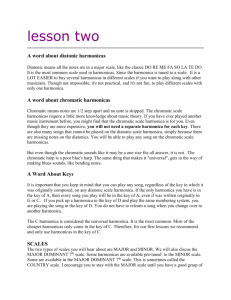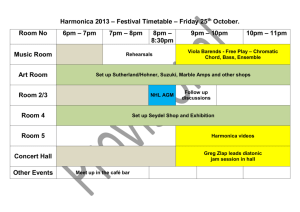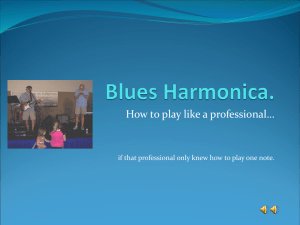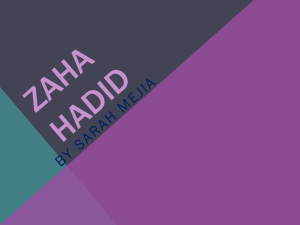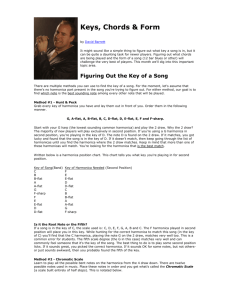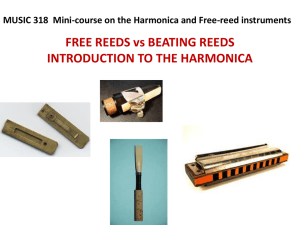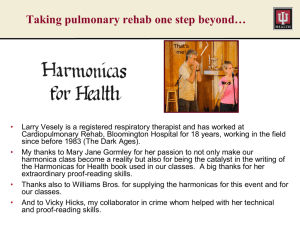Harmonica presentation M318 2.6.13 - CCRMA
advertisement
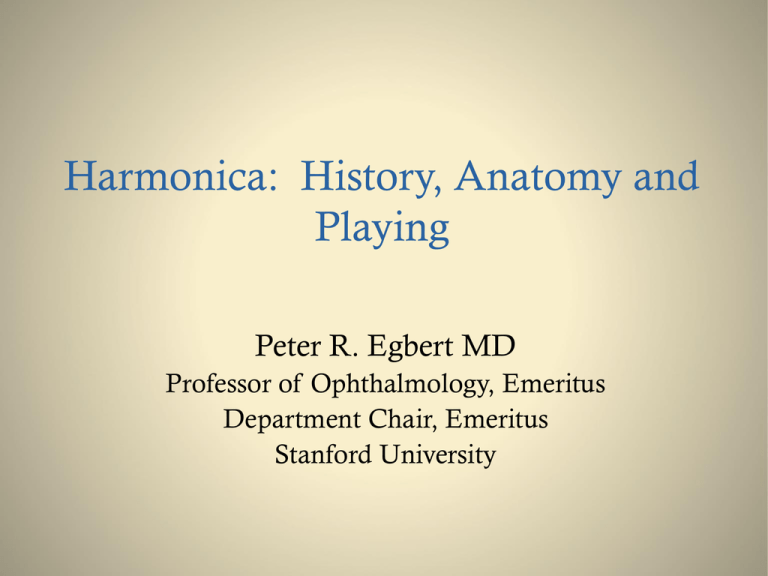
Harmonica: History, Anatomy and Playing Peter R. Egbert MD Professor of Ophthalmology, Emeritus Department Chair, Emeritus Stanford University • I have no conflict of interest or financial disclosures for this presentation History • Many instruments have been called “harmonica” or “mouth organ”, before the advent of the modern harmonica. • 3000 BC: Free-reed instruments were used in China and Asia (e.g. the sheng) • 1800’s: Modern diatonic harmonicas appeared . – 1821 Christian Buschman pitchpipe converted to instrument. – 1825-26 Richter 20 reeds in 10 holes ”mundharmonika”. – 1857 Matthias Hohner, a clock maker in Trossingen, Germany, began manufacturing harmonicas full time. Hohner Harmonica Company Trossigen, Germany • 1862-- first to export to North America • 1890-- 1,000,000/year • 1907-- 7,000,000 annually; 887,000 reeds from 15 tons of brass each day. – Many different models • Today many competitors – Lee Oscar, Seydel, Huang, etc. Most popular musical instrument? • “The only thing rarer than a person who has never owned a harmonica is a person who does it justice.” • “You cannot be everywhere unless you can go everywhere.” – Portable, sturdy • “An accordion with soul.” – Draw and blow notes – Breathe and play Soul • Pocket Full of Soul • Grass Valley (CA) showing 2/28 https://www.tugg.com/go/36unaq Two main classes of harmonicas • 10 hole diatonic – Expressive – Not all notes available – Blues • Chromatic – All notes available – Jazz, classical Anatomy of a harmonica Reed plate and reeds Cross section of air chamber and reeds Bahnson HT et al. J Am Soc Acoustics.1998:103(4) 2134 -2144 Standard tuning The 10 hole diatonic harmonica is a transposing instrument with various keys. Note that the chord degrees are the same on all the harmonicas. Two main embouchures • Tongue block – The lips cover up to 4 holes. – The tongue blocks all but the right hole (see MRI). • Pucker or lip block. – The lips cover all but one hole. Tongue block embouchure L T OC Playing your harmonica 1. Chords 2. Single note 1. 2. 3. 4. 5. 6. 7. Tongue blocking Lip blocking or puckering Slaps and pulls Octaves Vibrato Hand effects Pitch bending Standard tuning Cross section of air chamber and reeds Bahnson HT et al. J Am Soc Acoustics.1998:103(4) 2134 -2144 2 hole draw bend Start on G End on about F sharp Blow reed displaceme nt Draw reed displacement Bahnson HT et al. J Am Soc Acoustics.1998:103( 4) 2134 -2144 Anatomy of the Vocal Tract 3 hole draw note, no bend HP NC OC SP OPh Tongue M E HPh VF Tr CV 3 hole draw note, minor third bend 10cm MRI Harmonica study group • Thomas Rossing, Professor of Music, CCRMA • David Barrett, Professional Harmonica player and teacher. Bluesharmonica.com • Lewis Shin MD, Alex Holbrook PhD, Stanford Dept. of Radiology
